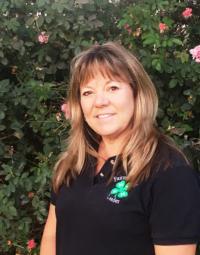

Tracy Newton
4-H Community Education Specialist
(559) 241-7525
Mailing Address:
550 E. Shaw Ave. Ste. #210-B
UC Center
Fresno, CA 93710
Email: tlnewton@ucanr.edu
Donations by mail:
Fresno County 4-H
550 E. Shaw Ave. Ste 210-B
Fresno, CA 93710

Elizabeth Ramirez
4-H Admin Support
(559) 241-7519
Mailing Address:
550 E. Shaw Ave. Ste.#210-B
UC Center
Fresno, CA 93710
Email: elramirez@ucanr.edu

About 4-H
Who We Are
4-H is a non-profit, informal educational youth development program. At the national level, 4-H is directed by an assistant deputy director and a staff for 4-H and other youth programs in the U.S. Department of Agriculture. In California, the 4-H program is conducted by the University of California Cooperative Extension. In each county, local Extension staff are authorized to administer the program in accordance with policies set by the University of California System and the Cooperative Extension. In Fresno County, the University of California Cooperative Extension staff includes a 4-H Youth Program Representative and a 4-H secretary. At the club level, the Community Club Leaders and the project leaders are adult volunteers. These adults accept the responsibility of being a leader because they enjoy teaching and working with 4-H members. Junior leaders are members in the seventh through ninth grade who assist leaders in leading projects. Teen leaders are members in tenth grade or above who lead project groups with a leader present.
What We Offer
The 4-H Youth Development Program offers many programs for youth throughout the country and some around the world. 4-H offers projects to enrich skills, meetings to encourage social development and participation within club activities, camps, conferences, trips, exchange programs, and many other events meant to benefit the youth who are involved in this program. This page offers examples of a few opportunities available in 4-H. For more information, please contact the UCCE/4-H Office.
Meetings
4-H members who participate in a club may elect a board of officers and plan, implement, and evaluate an annual Plan of Work. An adult volunteer, the Community Club Leader, coaches the officers and members in activities and guides them as they develop their leadership abilities. Parents/Guardians of members can actively participate in discussions, but only 4-H members may vote on issues brought before the club. Meetings allow members and parents/guardians to share information and experiences.
4-H Projects
Projects allow members to learn by doing activities and completing planned objectives. Project selection should be based on: interests, needs, time available, family situation, suitability to area of residence, and availability of necessary tools and equipment.
Some projects offered by the 4-H program include: Arts & Crafts, Camping & Backpacking, Citizenship, Clothing & Textiles, Service Learning, Computers, Dog Care, Food & Nutrition, Gardening, Guide Dogs, Leathercraft, Livestock, Photography, Rocketry, Shooting Sports, Small Animals, Woodworking. Members may design individual projects or participate in any approved project for which a leader is available.
Keola 4-H Camp Program
4-H members can participate in the Camp Program. This five day extravaganza at Huntington Lake is one 4-H'ers will not want to miss! Camp is organized by JCs (Junior Counselors) with the supervision of adult counselors. At camp, members are involved in a variety of sessions and activities which provide entertainment and learning opportunities.
The 4-H Motto: "To Make the Best Better"
The 4-H Slogan: "Learn by Doing"
The 4-H Pledge
As a true 4-H member, I pledge:
My Head to clearer thinking,
My Heart to greater loyalty,
My Hands to larger service,
My Health to better living,
for my club, my community, my country, and my world.
The 4-H Creed: I believe in 4-H for the opportunity it will give me to become a useful citizen. I believe in the training of my head for the power it will give me to think, plan, and reason. I believe in the training of my heart for the nobleness it will give me to become kind, sympathetic, and true. I believe in the training of my hands for the ability it will give me to become helpful, useful, and skillful. I believe in the training of my health for the strength it will give me to enjoy life, to resist disease, and to work efficiently. I believe in my country, my state, my community, and in my responsibility for their development. In all these things I believe, and I am willing to dedicate my efforts to their fulfillment.
The Goals of the 4-H Program
The goals of the 4-H program are to help young people:
• Develop initiative and assume responsibility.
• Develop leadership and be of service to others.
• Develop the ability to live and work cooperatively with others
• Acquire knowledge and skills and explore careers.
• Acquire satisfaction from work and accomplishments.
• Choose from alternatives and plan satisfying lives.
• Develop positive self images.
History of the 4-H Program
In the 1890's and early 1900's, educators in several states throughout the U.S. developed programs to teach farm children useful skills. In the early 1900's, corn, canning, and poultry projects began in several Midwestern and Southern states. These groups were led by teachers and school superintendents and stressed the importance of learning by doing. In 1902, A. B. Graham started one of the first 4-H clubs similar to the current 4-H clubs in Ohio. The club held regular meetings and planned programs. The U.S. Department of Agriculture encouraged the formation of the clubs. Southern land-grant colleges joined the Department of Agriculture in sponsoring the programs. In 1914, the Cooperative Extension System was set up by the Smith-Lever Act. The Smith-Lever Act also established federal funding for states in order to organize agricultural clubs for youth. After the Smith-Lever Act was passed, each state soon set up a club department. During the early 1920's, the agricultural groups adopted the 4-H emblem and the name 4-H Club. Over 80 nations now have 4-H or similar programs in order to help youth develop useful skills and become productive citizens. Although the 4-H program began as an agricultural program, it has expanded to include many programs which appeal to both city and rural youth.
To learn more about 4-H in California Statewide, go to the California 4-H Website.
